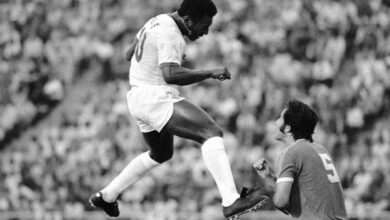Premier League flexes financial muscle to continue unsettling trend

By the time the last offer from England came in, Ajax officials were almost sneering. Everton had sent a £15m-plus bid in for Mohammed Kudus, but the Dutch champions were never going to even consider it. Aside from the fact they believe the Ghanaian will soon be worth multiple times that, their long-term plan had only allowed for a certain number of sales this summer.
It would take silly money to change that. The type of money, coincidentally, that Manchester United paid for Antony. As recently as Saturday, Ajax were adamant they weren’t going to sell the Brazilian, until the Old Trafford hierarchy made an €100m offer that “was just too much to leave on the table”. Ajax felt it would be ludicrous to turn it down.
While it almost became unfairly easy to scrutinise United over this window, the Antony deal does sum up so much of the Premier League’s summer market. It involved a genuinely astounding figure for a player who couldn’t be classed as “essential”, the amount ultimately leaving foreign officials with conflicting feelings of giddiness and helplessness.
Ajax were far from the only club thinking that way. The Antony deal is one of many you can point to as symbolic of something bigger.
There’s Nottingham Forest spending more than the entire Eredivisie, or bottom-half clubs being able to pay higher wages than AC Milan.
It is for once the overall figures, though, that really give the best picture.
By the time the window closed, the Premier League had a net spend of £1.13bn. The next closest domestic competition was La Liga, with £40m, and after that Russia, Turkey and Cyprus. If some of those leagues sound surprising, it is only an illustration of how much Premier League expenditure has diluted the rest. The gaps are even greater if you go out to gross spend. The Premier League spent well over £1bn more than any other league, and almost as much as Italy, France, Germany and Spain combined.
As regards the individual deals that formed these figures, the breathless headlines announcing them often sat beside serious real-life reports about the energy crisis, a worsening economy and people being unable to pay bills.
It is difficult not to see such a contrast as both obscene and absurd, but we really are way beyond such simplistic moralistic statements with football. The point is no longer that the game is separate from society, in its own bubble. It is that football foreshadows society, and reflects it before a mirror is even held up. Just as the relative frivolities of the sport first witnessed the partisan social media that now governs politics, as well as a map of the world’s questionable money, it is now seeing the effects of profound economic disparity. The capitalistic inequalities built into football’s infrastructure are starting to see that infrastructure creak, and crack. Just like the UK in 2022.
The big question is how sustainable all this is.
That isn’t to say that the game will collapse altogether. It is that the basics are no longer working, and it is all splitting. The sport’s fundamental unpredictability is being eroded. We’ve already seen two all-English Champions League finals in the last four seasons. The direction of travel is clear. The Premier League is reshaping the entire game.
As of now, in the summer of 2022, it has thinned and stretched the European pyramid in a way never seen before. The Premier League is obviously at the very top alongside Paris Saint-Germain, with a handful of other super-clubs just below, and then the domestic competitions going down in descending order.
We can barely talk about the “five major leagues” any more. It is really one super league, to repeat another point everyone in European football is saying. Little wonder big clubs elsewhere want to create their own.
Agents meanwhile talk in terms of proximity to the Premier League, with that prospect framing entire career decisions. Whereas they might previously have advised young players to go to the Netherlands or Switzerland to develop, representatives now stress it is better to stay in Spain, Italy, Germany or France because these are the new feeder leagues to England’s finances.
Premier League money can completely change a club’s plans, too, as Ajax have illustrated. Even the most lauded models, like at Sevilla, were effectively waiting for that money to come in before belatedly beginning their own summer recruitment.
Arsenal appear to have spent their money wisely
It is that same international scope that insulates the Premier League, too. Even if there is economic collapse in England – a remarkable sentence to so blithely state in a football article – £5bn of broadcasting money still comes from abroad. The Premier League will be able to keep the lights on. Maybe literally.
It shouldn’t escape anyone’s attention, of course, that two energy powers – Saudi Arabia and Abu Dhabi – are running sportswashing projects in the same competition.
That drives much of this, further inflating the market and steepening the pyramid. Even big-six business, such as with Arsenal and Chelsea, revolved around City cast-offs. It is one reason why the fixation on Erling Haaland’s transfer fee is so misplaced, given that so few clubs could afford his wages or the associated fees. It’s maybe the signing of the summer, but not that much of a steal.
By the same token, many selling clubs inflated prices by several levels once they had Premier League interest. Some of those negotiations were still described as remarkably straightforward, with little bartering. The European club would name a price, and the Premier League club could usually afford to pay it with ease.
Summer 2022 highest gross spend in European market
Premier League £1.9bn
Serie A £645m
Ligue 1 £476m
La Liga £435m
Bundesliga £417m





